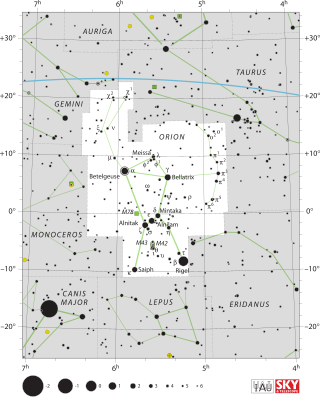From Wikipedia, the free encyclopedia
In modern astronomy, a constellation is a specific area of the celestial sphere as defined by the International Astronomical Union (IAU). These areas had their origins in star patterns from which the constellations take their names. There are 88 officially recognized constellations, covering the entire sky. When astronomers say an object is "in" a given constellation, they mean it is within the boundaries of one of these defined areas of sky.
Other cultures also have, or had, their own constellations, such as Chinese, Hindu and Australian Aboriginal. The names of these constellations are not recognized by the IAU.
Terminology
The Late Latin term constellātiō can be translated as "set of stars". The term was first used in astrology, of asterisms that supposedly exerted influence, attested in Ammianus (4th century). In English the term was used from the 14th century, also in astrology, of conjunctions of planets. The modern astronomical sense of "area of the celestial sphere around a specific asterism" dates to the mid-16th century.Colloquial usage does not distinguish the senses of "asterism" and "area surrounding an asterism". The modern system of constellations used in astronomy focuses primarily on constellations as grid-like segments of the celestial sphere rather than as patterns, while the term for a star-pattern is asterism. For example, the asterism known as the Big Dipper corresponds to the seven brightest stars of the larger IAU constellation of Ursa Major.
The term circumpolar constellation is used for any constellation that, from particular latitude on Earth, never sets below the horizon. From the North Pole, all constellations north of the celestial equator are circumpolar constellations. In the northern latitudes, the informal term equatorial constellation has sometimes been used for constellations that lie to the south of the circumpolar constellations.[1] Depending on the definition, equatorial constellations can include those that lie entirely between declinations 45° north and 45° south,[2] or those that pass overhead between the tropics of Cancer and Capricorn. They generally include all constellations that intersect the celestial equator.
Usually the only thing the stars in a constellation have in common is that they appear near each other in the sky when viewed from the Earth. In space, the stars in a constellation can be very far away from each other, because a bright star very far away is as visible to an observer on the Earth as a dim star closer to the Earth. Constellations whose stars are "near" each other include the five central stars of the Big Dipper in the constellation of Ursa Major.
Since stars travel on their own orbits through their galaxy, constellations change slowly and can even disappear. This takes tens of thousands of years.[3]
History
The current list of 88 constellations recognized by the International Astronomical Union since 1922 is based on the 48 listed by Ptolemy in his Almagest in the 2nd century.[4][5] Ptolemy's catalogue is informed by Eudoxus of Cnidus, a Greek astronomer of the 4th century BC who introduced earlier Babylonian astronomy to the Hellenistic culture.Ancient near East
The oldest catalogues of stars and constellations are from Old Babylonian astronomy, beginning in the Middle Bronze Age. The numerous Sumerian names in these catalogues suggest that they build on older, but otherwise unattested, Sumerian traditions of the Early Bronze Age. The classical Zodiac is a product of a revision of the Old Babylonian system in later Neo-Babylonian astronomy 6th century BC. Knowledge of the Neo-Babylonian zodiac is also reflected in the Hebrew Bible. E. W. Bullinger interpreted the creatures appearing in the books of Ezekiel (and thence in Revelation) as the middle signs of the four quarters of the Zodiac,[6][7] with the Lion as Leo, the Bull is Taurus, the Man representing Aquarius and the Eagle standing in for Scorpio.[8] The biblical Book of Job also makes reference to a number of constellations, including עיש `Ayish "bier", כסיל Kĕciyl "fool" and כימה Kiymah "heap" (Job 9:9, 38:31-32), rendered as "Arcturus, Orion and Pleiades" by the KJV, but `Ayish "the bier" actually corresponding to Ursa Major.[9] The term Mazzaroth מַזָּרוֹת, a hapax legomenon in Job 38:32, may be the Hebrew word for the zodiacal constellations.The Greeks adopted the Babylonian system in the 4th century BC. A total of twenty Ptolemaic constellations are directly continued from the Ancient Near East. Another ten have the same stars but different names.[10]
Ancient Egyptian star charts and astronomical ceilings
In ancient Egypt, the observation of stars such as Sirius in the day and night sky were used from a very ancient period, in order to predict the Nile Flood.[11] This practical observation of the stars was also associated with a very complex cosmology that involved various gods and spirits, some of whom were associated with stars and heavenly bodies, such as Sothis/Sopdet, who was likely associated with Sirius and Sah who was associated with Orion.[12][13] This cosmology and practice of astronomy eventually led to the Egyptians producing decanal clocks on coffin lids[14] and star charts featuring their gods and star observations on the ceilings of tombs and temples. Over time these became more complex, featuring various human and anthropomorphic figures representing the planets, stars and various constellations.[14] This tradition was later combined with Greek and Babylonian astronomical systems under the Ptolemies culminating in the Zodiac of Dendera. The first circular zodiac showing all the constellations we are familiar with, along with Egyptian Constellations, Decans and Planets.[15][16]Hindu or Indian Constellation
Nakshatra (Devanagari: nákṣatra) is the term for lunar mansion in Hindu astrology. A nakshatra is one of 27 (sometimes also 28) sectors along the ecliptic. Their names are related to the most prominent asterisms in the respective sectors.The starting point for the nakshatras is the point on the ecliptic directly opposite to the star Spica called Chitrā in Sanskrit (other slightly different definitions exist). It is called Meshādi or the "start of Aries".[citation needed] The ecliptic is divided into each of the nakshatras eastwards starting from this point. The number of nakshatras reflects the number of days in a sidereal month (modern value: 27.32 days), the width of a nakshatra traversed by the Moon in about one day. Each nakshatra is further subdivided into four quarters (or padas). These play a role in popular Hindu astrology, where each pada is associated with a syllable, conventionally chosen as the first syllable of the given name of a child born when the Moon was in the corresponding pada.
The nakshatras of traditional bhartiya astronomy are based on a list of 28 asterisms found in the Atharvaveda (AVŚ 19.7) and also in the Shatapatha Brahmana.[citation needed] The first astronomical text that lists them is the Vedanga Jyotisha.
In classical Hindu mythology (Mahabharata, Harivamsa), the creation of the nakshatras is attributed to Daksha. They are personified as daughters of the deity and as mythological wives of Chandra, the Moon god, or alternatively the daughters of Kashyapa, the brother of Daksha.[17]
Each of the nakshatras is governed as 'lord' by one of the nine graha in the following sequence: Ketu (South Lunar Node), Shukra (Venus), Ravi or Surya (Sun), Chandra (Moon), Mangala (Mars), Rahu (North Lunar Node), Guru or Brihaspati (Jupiter), Shani (Saturn) and Budha (Mercury). This cycle repeats itself three times to cover all 27 nakshatras. The lord of each nakshatra determines the planetary period known as the dasha, which is considered of major importance in forecasting the life path of the individual in Hindu astrology.
In Vedic Sanskrit, the term nákṣatra may refer to any heavenly body, or to "the stars" collectively. The classical sense of "lunar mansion" is first found in the Atharvaveda, and becomes the primary meaning of the term in Classical Sanskrit.
Greece-Roman
There is only limited information on indigenous Greek constellations. Some evidence is found in Hesiod.[clarification needed] Greek astronomy essentially adopted the older Babylonian system in the Hellenistic era, first introduced to Greece by Eudoxus of Cnidus in the 4th century BC. The original work of Eudoxus is lost, but it survives as a versification by Aratus, dating to the 3rd century BC.The most complete existing works dealing with the mythical origins of the constellations are by the Hellenistic writer termed pseudo-Eratosthenes and an early Roman writer styled pseudo-Hyginus.
The basis of western astronomy as taught during Late Antiquity and until the Early Modern period is the Almagest by Ptolemy, written in the 2nd century.
Classical Chinese constellations
In classical Chinese astronomy, the northern sky is divided geometrically, into five "enclosures" and twenty-eight mansions along the ecliptic, grouped into Four Symbols of seven asterisms each. The 28 lunar mansions are one of the most important and also the most ancient structures in the Chinese sky, attested from the 5th century BC. Parallels to the earliest Babylonian (Sumerian) star catalogues suggest that the ancient Chinese system did not arise independently from that of the Ancient Near west and East.[18] Classical Chinese astronomy is recorded in the Han period and appears in the form of three schools, which are attributed to astronomers of the Zhanguo period. The constellations of the three schools were conflated into a single system by Chen Zhuo, an astronomer of the 3rd century (Three Kingdoms period). Chen Zhuo's work has been lost, but information on his system of constellations survives in Tang period records, notably by Qutan Xida. The oldest extant Chinese star chart dates to the Tang period and was preserved as part of the Dunhuang Manuscripts. Native Chinese astronomy flourished during the Song Dynasty, and during the Yuan Dynasty became increasingly influenced by medieval Islamic astronomy.[19]Early Modern era
The constellations around the South Pole were not observable from north of the equator, by Babylonians, Greeks, Chinese or Arabs.The modern constellations in this region were defined during the age of exploration, notably by Dutch navigators Pieter Dirkszoon Keyser and Frederick de Houtman at the end of sixteenth century. They were depicted by Johann Bayer in his star atlas Uranometria of 1603.[20] Several more were created by Nicolas Louis de Lacaille in his star catalogue, published in 1756.[21]
Some modern proposals for new constellations were not successful; an example is Quadrans, eponymous of the Quadrantid meteors, now divided between Boötes and Draco. The classical constellation of Argo Navis was broken up into several different constellations, for the convenience of stellar cartographers.
By the end of the Ming Dynasty, Xu Guangqi introduced 23 asterisms of the southern sky based on the knowledge of western star charts.[22] These asterisms have since been incorporated into the traditional Chinese star maps.
IAU constellations

Equirectangular plot of declination vs right ascension of the modern constellations with a dotted line denoting the ecliptic. Constellations are colour-coded by family and year established. (detailed view)
In 1930, the boundaries between the 88 constellations were devised by Eugène Delporte along vertical and horizontal lines of right ascension and declination.[25] However, the data he used originated back to epoch B1875.0, which was when Benjamin A. Gould first made the proposal to designate boundaries for the celestial sphere, a suggestion upon which Delporte would base his work. The consequence of this early date is that due to the precession of the equinoxes, the borders on a modern star map, such as epoch J2000, are already somewhat skewed and no longer perfectly vertical or horizontal.[26] This effect will increase over the years and centuries to come.
Asterisms

Much of the dark space between stars, as seen in the sky of the image above, is due to the human eye's low light sensitivity. Other images (like the Hubble Deep Field – not pictured) detect far more stars.
The brightest stars, usually the stars that make up the constellation's eponymous asterism, also retain proper names, often from Arabic. For example, the "Little Dipper" asterism of the constellation Ursa Minor has ten stars with Bayer designation, α UMi to π UMi. Of these ten stars, six have a proper name, viz. Polaris (α UMi), Kochab (β UMi), Pherkad (γ UMi), Yildun (δ UMi), Ahfa al Farkadain (ζ UMi) and Anwar al Farkadain (η UMi).
The stars within an asterism rarely have any substantial astrophysical relationship to each other, and their apparent proximity when viewed from Earth disguises the fact that they are far apart, some being much farther from Earth than others. However, there are some exceptions: many of the stars in the constellation of Ursa Major (including most of the Big Dipper) are genuinely close to one another, travel through the galaxy with similar velocities, and are likely to have formed together as part of a cluster that is slowly dispersing. These stars form the Ursa Major moving group.
Distances of stars in the Orion constellation (left) vary greatly. By contrast, the stars comprising the Big Dipper (right) are actually close to each other. The other stars of Ursa major have different distances.
Dark cloud constellations
The Great Rift, a series of dark patches in the Milky Way, is more visible and striking in the southern hemisphere than in the northern. It vividly stands out when conditions are otherwise so dark that the Milky Way's central region casts shadows on the ground. Some cultures have discerned shapes in these patches and have given names to these "dark cloud constellations." Members of the Inca civilization identified various dark areas or dark nebulae in the Milky Way as animals, and associated their appearance with the seasonal rains.[28] Australian Aboriginal astronomy also describes dark cloud constellations, the most famous being the "emu in the sky" whose head is formed by the Coalsack.-
The Emu in the sky—a constellation defined by dark clouds rather than by stars. The head of the emu is the Coalsack with the Southern Cross directly above. Scorpius is to the left.






